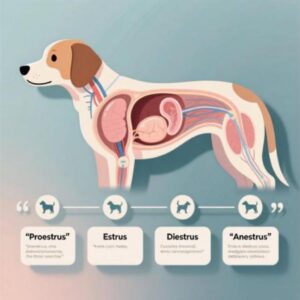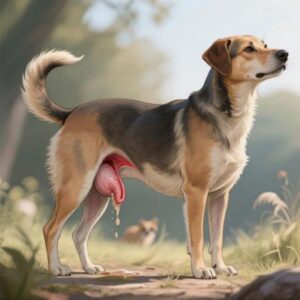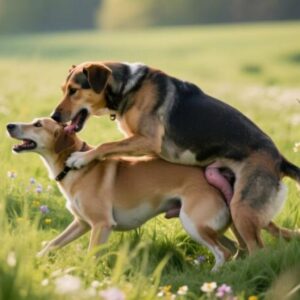A dog in heat can be confusing for many pet owners. The process is part of the dog heat cycle and shows clear signs you should know. Dogs in heat may act restless, seek more attention, or show changes in appetite. You might notice swelling, discharge, and other physical signs that mark this stage. Understanding the common behaviors of a female dog in heat helps you care for her better and avoid risks.
Many people ask, “how long do dogs stay in heat?” The answer depends on age, breed, and health. The dog heat cycle often lasts about three weeks, but symptoms vary. During this time, male dogs may try to approach her, so extra care is needed. Knowing what to expect when a dog in heat begins her cycle makes it easier to protect her health and manage her needs with confidence.
How Often Do Dogs Go Into Heat?
A dog in heat usually experiences her first cycle between six and twenty-four months of age. Smaller breeds may cycle earlier, while larger breeds often start later. On average, dogs go into heat about twice a year, though this can vary. Understanding timing helps prevent accidental pregnancies.
Once a dog in heat begins her regular cycles, most female dogs will have two heat cycles every twelve months. Some small breeds may experience three, while giant breeds might only have one. Each cycle follows phases: proestrus, estrus, diestrus, and anestrus, showing both physical and behavioral changes.
Regular cycles are important for tracking reproductive health. Skipping or irregular heats could signal medical issues that require veterinary attention. Pet owners should also note that spaying prevents heat cycles altogether. This not only stops unwanted litters but also reduces risks of infections and reproductive cancers later in life.
How Long Are Dogs In Heat?
A dog in heat usually stays in this phase for about 2 to 4 weeks. The length depends on breed, size, and overall health. Small breeds often have shorter cycles, while larger dogs may experience longer ones. Recognizing this timeline helps owners manage care and prevent unplanned mating.
Most dogs go through four heat cycle phases: proestrus, estrus, diestrus, and anestrus. When people ask, “How long are dogs in heat?” the answer varies, but the fertile period often lasts 7 to 10 days. During this time, female dogs attract males more strongly.
Keeping track of these cycles supports reproductive health and avoids unwanted pregnancies. Watch for signs like swollen vulva, discharge, and behavioral changes. A dog in heat needs extra attention, including separation from males and proper hygiene. Pet owners can use products like dog diapers or crates to help manage this stage.
Read More: Caring for a Labrador Retriever
Phases of a Dog’s Heat Cycle

A dog in heat goes through four main phases. Each stage shows different signs and lasts for a specific number of days. Knowing these phases helps you understand her behavior, protect her, and manage her reproductive health.
The heat cycle in dogs typically lasts two to four weeks. The timeline depends on breed and age. During these phases, changes in discharge, swelling, and behavior appear. Learning how long each stage lasts makes caring for a dog in heat much easier.
- Proestrus usually lasts 7–10 days, but it can extend to four weeks. During this stage, vulva swelling and blood-tinged discharge are common signs in a dog in heat.
- In proestrus, female dogs attract males but won’t allow mating. This period shows the first clear signals of the dog heat cycle, including swelling and behavioral changes.
- Estrus follows proestrus and generally lasts 5–10 days. It’s the fertile stage where females accept males. Vaginal discharge becomes lighter, showing ovulation in a dog in heat.
- During estrus, owners should avoid dog parks and keep dogs separated. Male attraction is strong in this phase, increasing the chance of accidental mating and pregnancy.
- Diestrus lasts about two months. Whether pregnant or not, hormone levels remain high. Dogs no longer accept males, and swelling or discharge gradually disappear during this stage.
- Diestrus may cause false pregnancy symptoms. Signs include nesting behavior, swollen nipples, or mild appetite changes. A veterinary examination helps confirm if pregnancy occurred or not.
- Anestrus is the resting phase, usually lasting 3–5 months. No mating behavior or swelling appears. This period prepares the dog’s body for the next heat cycle.
- Anestrus length varies between breeds. Small dog breeds may cycle every 4 months, while large dog breeds may only cycle once a year or less.
- The complete dog reproductive cycle is unique for each female. Monitoring symptoms, timing, and behaviors makes it easier to predict when the next dog in heat will start.
- The first heat in dogs usually occurs between 6–24 months. Smaller breeds tend to start earlier, while larger breeds often experience it much later in life.
- Owners must monitor vaginal discharge, swelling, and increased urination. These physical changes help identify the current stage of the dog heat cycle and avoid unexpected risks.
- Senior dogs face health concerns during the cycle. Pregnancy carries higher risks, and conditions like pyometra may appear. Regular veterinary checkups are essential for safe canine reproductive health.
When Do Dogs Go Into Heat?
Most female dogs experience their first heat between six and twelve months of age. Small breeds often enter sooner, while large breeds may not cycle until 18 to 24 months. Knowing the right timeline helps owners prepare for physical and behavioral changes that signal the start of fertility.
A dog in heat follows a cycle that repeats every six to eight months, though timing can vary by breed and health. Early signs include a swollen vulva, light bleeding, and behavioral shifts like restlessness. Tracking these changes ensures you provide proper care during this sensitive reproductive phase.
It’s important to note that dogs don’t go through menopause as humans do. They continue cycling throughout life, though frequency and intensity can change with age. Senior pregnancies carry serious health risks, so veterinarians often recommend spaying to prevent complications and protect long-term reproductive health.
Monitoring the first heat is vital for training and safety. Owners should avoid dog parks or unfenced yards during this period, as males will be highly attracted. Using dog diapers, gates, or crates can help manage behavior and protect your pet. Responsible care during heat reduces stress for both you and your dog.
Symptoms of a Dog In Heat

A dog in heat shows both physical and behavioral changes that signal her fertility cycle has started. You may notice swelling, discharge, or unusual restlessness. These signs are important to track so you can manage her health and safety.
Behavioral shifts also appear during this phase. Female dogs may become clingy, anxious, or even aggressive. Understanding these symptoms helps you prevent unwanted mating and take better care of her during this sensitive period of the reproductive cycle.
- Vulva swelling
- Vaginal discharge
- Restless behavior
- Increased urination
- Affection seeking
- Male dog attraction
- Swollen nipples
- Appetite changes
- Mounting behavior
- Aggression signs
- Excessive licking
- Mood swings
Do Dogs Go Through Menopause?
Unlike humans, dogs don’t experience menopause in the same way. Instead, their reproductive cycle continues throughout life. A dog in heat may still show signs even in older age. However, fertility decreases, and pregnancies become risky as they grow older.
Veterinarians confirm that dogs don’t have a true end to their heat cycle. Instead, hormonal shifts slow down over time. Older female dogs may experience irregular cycles, weaker symptoms, or longer gaps, but cycles don’t fully stop.
Health risks rise with age. Senior dogs face higher chances of complications like pyometra, a dangerous uterine infection. Late pregnancies can threaten both mother and puppies. That’s why spaying older dogs is often strongly advised by vets.
Some owners confuse reduced cycles with menopause. In reality, these changes reflect age-related hormone decline. Unlike humans, there’s no complete reproductive shutdown. Dogs keep cycling, though less often and with unpredictable patterns.
Caring for older female dogs requires extra attention. Watch for symptoms like discharge, swollen vulva, or changes in urination. Regular vet visits help track health. Preventing unplanned breeding becomes more important because senior pregnancies carry serious medical risks.
Spaying remains the safest option for preventing reproductive issues in older dogs. Removing ovaries and uterus eliminates heat cycles, pregnancy risks, and infections. Talk with your vet about the best time. Early prevention can protect long-term health and comfort.
What To Do When Your Dog Is In Heat

When your dog in heat starts showing signs, the first step is awareness. Watch for swelling, discharge, and behavioral changes. These symptoms help you recognize the cycle early. Quick action keeps your pet comfortable and avoids unnecessary stress or risks.
Keep your dog in heat separated from male dogs. Use dog crates or gates indoors for safety. A fenced-in yard isn’t always secure because determined males may find ways inside. Supervision protects your pet and prevents accidental dog pregnancy.
Consider dog diapers or wraps to handle discharge. Products like Paw Inspired Dog Diaper Pad Liners or Hartz Comfitables Diapers are helpful. They reduce mess at home and add comfort. Always check for absorbency and leakproof features to protect furniture.
Routine walks are fine, but avoid dog parks. Other dogs may react strongly, which creates fights or accidents. Instead, use quiet areas or private spaces. Control the environment during the heat cycle to limit risks and manage dog reproductive health.
Offer more affection, patience, and calm reassurance. A female dog may show restlessness or aggression. Sometimes, increased urination or swollen nipples appear too. Stay consistent with feeding and routine. These small adjustments make the process smoother for both of you.
Speak with your vet about long-term solutions. Spayed dogs avoid future cycles and health concerns like pyometra. The spay surgery removes ovaries and uterus, preventing pregnancy. Veterinary examination ensures timing is right and addresses questions about canine reproductive health and safety.
If you don’t plan to spay, track her fertility cycle in dogs carefully. Record dates of proestrus, estrus, and anestrus phases. This helps you predict future heat cycles. Careful monitoring reduces stress and allows better decisions for mating or prevention.
Ultimately, preparation is key when handling a female dog’s cycle. Use dog crates, diapers, or playpens as needed. Maintain safety, comfort, and hygiene throughout. With knowledge, tools, and care, managing the challenges of a dog in heat becomes much easier.
FAQ’S
How long does the cycle last?
A Dog In Heat usually stays in the cycle for two to three weeks. Signs like discharge, swelling, and behavior changes guide you through the timeline.
What age does it first happen?
Most dogs experience their first cycle between six and twenty-four months. Smaller breeds start earlier, while larger breeds may begin later.
Can senior dogs still get pregnant?
Yes, but pregnancy in older dogs carries higher risks. Veterinary advice is crucial for preventing health issues like pyometra or complications during late pregnancies.
How can I manage the mess?
Using diapers, pad liners, and body wraps keeps things clean. A Dog In Heat benefits from absorbent, leakproof products that provide comfort and household protection.
Should I allow mating during this time?
Careful supervision is necessary. A Dog In Heat attracts males strongly, and unsupervised contact may lead to unplanned litters. Responsible decisions prevent overpopulation and health concerns.
Conclusion
Caring for a Dog In Heat takes patience and planning. The dog heat cycle brings physical changes like vulva swelling, vaginal discharge in dogs, and swollen nipples. Behavioral shifts such as restlessness, affection, or even aggression are also common behaviors of a female dog in heat. During this time, increased urination and dog mating behavior are expected. Dog diapers, dog diaper pad liners, and dog body wraps can keep your home clean while supporting your pet’s comfort. Products like Paw Inspired Dog Diaper Pad Liners or Hartz Comfitables Diapers are great choices.
Managing dogs in heat also means preventing risks. Use dog crates, dog gates, or even a fenced-in yard for added safety. Avoid dog parks during heat since male dog attraction can cause problems. Veterinary examination is vital, especially to discuss spayed options or health issues like pyometra. With the right care, canine reproductive health stays balanced and your pet stays happy.


1 thought on “Dogs In Heat: Timeline, Duration, and Symptoms”